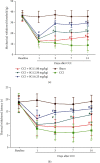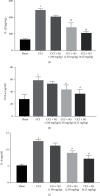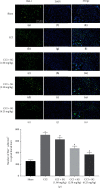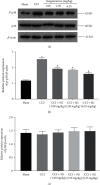Sanguinarine Attenuates Neuropathic Pain in a Rat Model of Chronic Constriction Injury
- PMID: 34409102
- PMCID: PMC8366402
- DOI: 10.1155/2021/3689829
Sanguinarine Attenuates Neuropathic Pain in a Rat Model of Chronic Constriction Injury
Abstract
Objective: There is still no effective treatment of neuropathic pain. Sanguinarine is a natural plant medicine with anti-inflammatory effects, but its effect on neuropathic pain remains unclear. This study was aimed at investigating the potential of sanguinarine to attenuate neuropathic pain.
Methods: Neuropathic pain was induced by chronic constriction injury (CCI) of the sciatic nerve. Rats were randomly divided into several groups: sham, CCI, CCI+SG (1.00 mg/kg), CCI+SG (2.50 mg/kg), and CCI+SG (6.25 mg/kg). SG was injected intraperitoneally from the day of surgery every three days. The mechanical withdrawal threshold (MWT) and thermal withdrawal latency (TWL) were recorded before surgery and on days 1, 3, 7, and 14 after surgery. The microglia in the spinal dorsal horn were examined by immunofluorescence. p38 MAPK expression in the spinal dorsal horn was detected by PCR and Western blot analysis. Cytokine levels in the spinal dorsal horn were measured by ELISA.
Results: MWT and TWL were significantly reduced in the CCI group, but sanguinarine recovered MWT and TWL in the CCI group. In addition, sanguinarine inhibited the activation of microglia and decreased the expression of p-p38 and TNF-α, IL-1β, and IL-6 in the spinal dorsal horn of the CCI group in a dose-dependent manner.
Conclusions: Our results suggest that sanguinarine can attenuate neuropathic pain via inhibiting the activation of microglia and the activation of the p38 MAPK signaling pathway.
Copyright © 2021 Ping Li et al.
Conflict of interest statement
The authors declare that they have no conflict of interest.
Figures




Similar articles
-
Sanguinarine Attenuates Neuropathic Pain by Inhibiting P38 MAPK Activated Neuroinflammation in Rat Model.Drug Des Devel Ther. 2020 Nov 4;14:4725-4733. doi: 10.2147/DDDT.S276424. eCollection 2020. Drug Des Devel Ther. 2020. PMID: 33177809 Free PMC article.
-
Licochalcone A Attenuates Chronic Neuropathic Pain in Rats by Inhibiting Microglia Activation and Inflammation.Neurochem Res. 2021 May;46(5):1112-1118. doi: 10.1007/s11064-021-03244-x. Epub 2021 Feb 8. Neurochem Res. 2021. PMID: 33555527
-
Montelukast attenuates neuropathic pain through inhibiting p38 mitogen-activated protein kinase and nuclear factor-kappa B in a rat model of chronic constriction injury.Anesth Analg. 2014 May;118(5):1090-6. doi: 10.1213/ANE.0000000000000174. Anesth Analg. 2014. PMID: 24686047
-
[Tetrahydropalmatine alleviated diabetic neuropathic pain by inhibiting activation of microglia via p38 MAPK signaling pathway].Zhongguo Zhong Yao Za Zhi. 2022 May;47(9):2533-2540. doi: 10.19540/j.cnki.cjcmm.20220119.702. Zhongguo Zhong Yao Za Zhi. 2022. PMID: 35531701 Chinese.
-
Levo-corydalmine attenuates microglia activation and neuropathic pain by suppressing ASK1-p38 MAPK/NF-κB signaling pathways in rat spinal cord.Reg Anesth Pain Med. 2020 Mar;45(3):219-229. doi: 10.1136/rapm-2019-100875. Epub 2020 Jan 2. Reg Anesth Pain Med. 2020. PMID: 31898581
Cited by
-
Sanguinarine-Chelerythrine from Coptis chinensis Offers Analgesic and Anti-Inflammatory Effects Without Gastrotoxicity.Pharmaceutics. 2025 Mar 2;17(3):323. doi: 10.3390/pharmaceutics17030323. Pharmaceutics. 2025. PMID: 40142987 Free PMC article.
-
RNA interference-mediated silencing of DNA methyltransferase 1 attenuates neuropathic pain by accelerating microglia M2 polarization.BMC Neurol. 2022 Oct 1;22(1):376. doi: 10.1186/s12883-022-02860-6. BMC Neurol. 2022. PMID: 36183073 Free PMC article.
-
Attenuation of cisplatin-induced acute kidney injury by sanguinarine: modulation of oxidative stress, inflammation, and cellular damage.Front Pharmacol. 2025 Apr 2;16:1567888. doi: 10.3389/fphar.2025.1567888. eCollection 2025. Front Pharmacol. 2025. PMID: 40242453 Free PMC article.
-
Research Progress on Neuroprotective Effects of Isoquinoline Alkaloids.Molecules. 2023 Jun 16;28(12):4797. doi: 10.3390/molecules28124797. Molecules. 2023. PMID: 37375352 Free PMC article. Review.
-
Cimifugin Alleviates Chronic Constriction Injury of the Sciatic Nerve by Suppressing Inflammatory Response and Schwann Cell Apoptosis.Cell Biochem Biophys. 2025 Mar;83(1):823-836. doi: 10.1007/s12013-024-01513-4. Epub 2024 Oct 11. Cell Biochem Biophys. 2025. PMID: 39392551
References
-
- Terayama R., Omura S., Fujisawa N., Yamaai T., Ichikawa H., Sugimoto T. Activation of microglia and p38 mitogen-activated protein kinase in the dorsal column nucleus contributes to tactile allodynia following peripheral nerve injury. Neuroscience. 2008;153(4):1245–1255. doi: 10.1016/j.neuroscience.2008.03.041. - DOI - PubMed
MeSH terms
Substances
LinkOut - more resources
Full Text Sources
Medical

